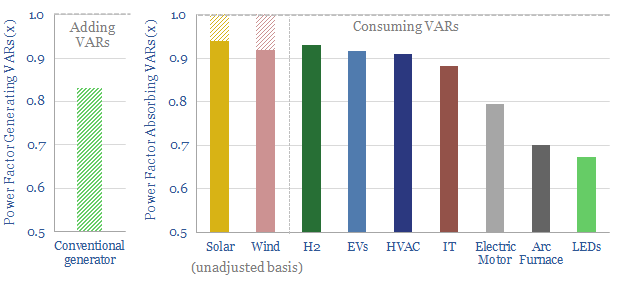Wind and solar power factor corrections could save 0.5% of global electricity, with $20/ton CO2 abatement costs at typical facilities in normal times, and 30% pure IRRs during energy shortages. They will also be needed to integrate more new energies into power grids. This 17-page note outlines the opportunity in capacitor banks, their economics and leading companies.
Reactive power is needed to create magnetic fields within ‘inductive loads’ like motors, electric heat, IT hardware and LEDs. But it is wasteful. 0.8-0.9 x power factors mean that 10-20% of the flowing current is not doing any useful work; it is simply amplifying I2R resistive losses; and if it is not compensated, then voltage drops can de-stabilize the grid.
All of these statements might seem a little bit confusing. Hence, after reading hundreds of pages into this topic, our ‘best explanation’ of the physics, the problem and the solution are set out on pages 2-6 of the report. We would also recommend the excellent online videos from the Engineering Mindset.
Power factor correction technologies are seen accelerating for three reasons. Saving electricity is increasingly economic amidst energy shortages (pages 7-8).
Second, they will enable greater electrification for around 30% less capex (pages 9-11).
Third, the rise of renewables will see large rotating turbines (especially coal) replaced with distributed generators that inherently offer no reactive power (wind and solar). This is not a “problem”. It simply requires conscious power factor correction (pages 12-14).
What challenges? Capacitor banks are likely to be the lowest cost solution for power factor correction, but they are also competing with other technologies, as reviewed on page 15. For ultra-high quality grid-scale wind and solar power-factor corrections, we think there is greater upside in STATCOMs (note here).
What opportunities? Leading companies are profiled on pages 16-17, based on reviewing patents, and include the usual suspects in power-electronic capital goods.
